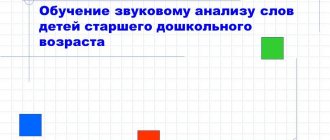Features of the formation of sound culture of speech of preschool children
A child’s speech is formed based on the example of verbal communication of the adults who surround him. For some parents and grandparents, it becomes a discovery that even with a baby it is inadmissible to lisp and adapt to baby talk. From the first days of life, children should hear gentle, but at the same time correct speech in terms of grammar and pronunciation. Only in this way will the development of coherent speech in preschool children occur naturally and fully.
Starting from the age of three, a preschooler will begin to repeat after adults word by word. It is extremely important that his onomatopoeia is based on distinct, correctly pronounced phrases.
Sound pronunciation
The sound aspect of speech in preschool children changes every month due to the natural improvement of the speech apparatus.
Children 3-4 years old have a characteristic speech feature that consists in softening almost all words. Most children do not yet pronounce the sound R, hissing Zh, Ch, Sh, Shch.
There is a frequent replacement of more complex sounds (so-called back-lingual) with simple (front-lingual) at the beginning of a word. Follow the movement of your tongue: it is much easier to pronounce “shuk” instead of beetle, “dolova” rather than head, “Tatya” instead of Katya.
Several consonant sounds in a row completely turn children’s phrases into new lexical inventions.
By the age of five, most children get rid of general softening. The pronunciation of words is still unstable, but almost all sounds are being mastered. Another thing is that the child does not always manage to use them appropriately. To rejoice that R, Zh and other insidious sounds have already succumbed, the preschooler uses them, replacing the quite loyal pronunciation L, T, S. For this reason, you can hear from the child “rapka” (paw), “zhuby” (teeth) and similar word creation.
Children of senior preschool age, in general, pronounce all sounds clearly, unless there are functional deviations (lisp, stuttering), the elimination of which requires special speech therapy assistance. But in six-year-olds, the rearrangement of sounds or syllables, as well as the distortion of words familiar to the immediate circle (“meat grinder”, “velisaped”) can become fixed. The reason may be either imitation, undeveloped speech hearing, or weak voluntary attention.
We recommend that you read:
- How to teach a child to pronounce the letter R.
- Speech therapy exercises for the sound L.
- Making whistling sounds.
Characteristics of speech expressiveness
The formation of sound expressiveness of speech occurs when the preschooler’s statements acquire coherence. Children grasp the melody of pronunciation of sentences before they begin to speak. Intonation, logical stress in a sentence comes when the child begins to speak meaningfully.
Elements of speech expressiveness are an important component of sound culture. Intonation and clarity of pronunciation not only add beauty to the sound. The delivery of the meaning of the message and the understanding of the content by the listener depend on them. The development of expressive speech in children can be ensured by reciting poetry and participating in theatrical performances.
Pace and speech breathing
The peculiarities of assimilation of the sound side of speech by preschoolers are also due to the fact that the child’s body has a poorly developed system of respiratory muscles and respiratory tract.
Therefore, the child may not finish words, skip complex sound combinations, and speak excessively hastily. At the same time, speech sounds excited or loud.
It is important to develop your child's breathing muscles by practicing deep inhalations and exhalations.
Exercises where you have to blow for as long as possible are useful. Blowing soap bubbles, blowing on a dandelion ball, or a competition to see who can blow a checker further on a chessboard are suitable. Such simple games develop the speech breathing of a preschooler.
Didactic games
Phonemic awareness and the ability to recognize non-speech sounds can be trained using the Orchestra game. Children stand with their backs to the teacher, who makes sounds using various instruments. At first, it is advisable to give one instrument for recognition. For example, a ratchet. Then simultaneously offer 2 sounds - a rattle and a drum. Gradually increase the number of sounds. Children must say what musical instruments they heard in the orchestra.
Didactic games are suitable for differentiating sounds, in which you need to distribute given sounds into 2 groups. For example, in the game “Colorful Baskets,” the speech therapist pronounces the names of objects and phenomena, and children pick up an orange basket if they hear one sound in a word, and a yellow basket if they hear another. Similar tasks can be implemented by distributing words with the required sounds into different houses, cabinets, pots, etc.



